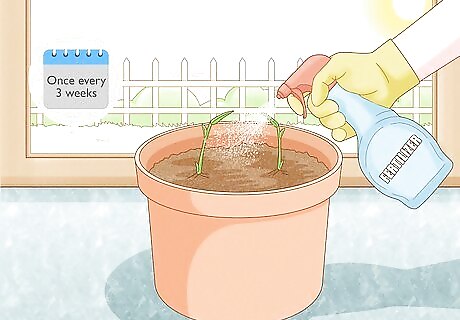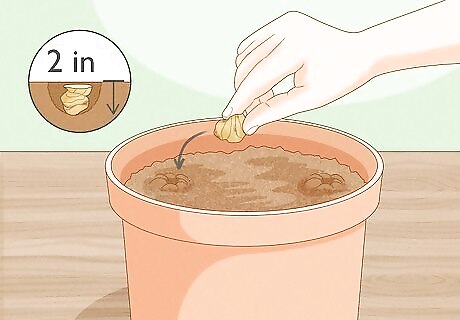
views
- Cut a store-bought ginger root into 1–1.5 in (2.5–3.8 cm) pieces, with 1 or 2 knobby buds on each piece.
- Plant the pieces in a 12 in (30 cm) clay pot with nutrient-rich potting mix, and keep the soil moist but not too wet.
- Keep the ginger plants at about 68 °F (20 °C) in direct sunlight, and apply liquid fertilizer once every few weeks.
- Harvest your ginger when it’s 8-10 months old, digging up the entire plant, trimming off the shoots, and saving some root chunks for replanting.
Planting Ginger

Purchase and cut a ginger rhizome into 1–1.5 in (2.5–3.8 cm) pieces. At your local grocer, select a root that’s firm and at least 5 in (13 cm) long, with several visible buds. Then, cut the root into chunks (making sure each chunk has at least 1 bud) and leave the chunks on the counter for about 3 days to let them heal—the exposed inside will begin to callous over. In addition, soak store-bought ginger rhizomes in water overnight to rinse off any anti-growth chemicals the grocer may have added. Cutting your ginger root into pieces allows for more opportunity to plant and grow a successful ginger plant. This guide covers Zingiber officinale. Most Zingiber species will grow under similar conditions, but for best results follow the nursery instructions.

Plant each root chunk in a 12 in (30 cm) clay pot with nutrient-rich soil. Ginger thrives on high-quality, well-draining soil. Mix loamy potting soil with well-rotted compost or thick mulch. Then, fill the pot with the soil, leaving about 1 inch (2.5 cm) of space at the top, and plant the ginger 2 inches (5.1 cm) beneath the surface, laid horizontally. Alternatively, plant the chunks in a larger pot or in outdoor soil about 6–8 in (15–20 cm) apart. Like most garden plants, ginger prefers mildly acidic soils. If soil in your area is alkaline, adjust it to between 6.1 and 6.5 pH using a garden store pH kit. If you’re planting outside in a seasonal climate, plant your ginger in mid-spring, since ginger is a tropical plant that does not survive frost. Plant after the last spring frost, or at the start of the wet season if you live in the tropics.

Place the pot in direct sunlight, and water until the soil is moist. Ginger loves sunshine, so choose a spot that gets about 2-5 hours of direct sunlight each day. In addition, make sure the spot stays at about 68 °F (20 °C) and doesn’t dip below 50 °F (10 °C). Then, water the soil until it’s moist but not outright wet or flooded.
Growing Ginger

Keep the soil damp. Check the soil daily and water just before it dries out completely. Soggy soil will quickly rot your plants, so reduce watering or move the plant to a pot with better drainage if water does not drain quickly. In addition to regular watering, spray the aboveground portion of the plant about once a day with a spray bottle to keep it misted and hydrated in dryer climates.

Fertilize the soil every few weeks after sprouts appear. Ginger typically takes about 3-8 weeks to break through the surface of the soil. Once you spot a sprout, apply liquid fertilizer to the soil (according to the instructions on the packaging) every 3 weeks to help the sprout grow tall and healthy. In addition, add a thin layer of mulch to the surface of an outdoor ginger plant’s soil after sprouting to fend off weeds and retain water.\

Optionally, transplant your ginger as the seasons change. While not required, ginger benefits from some time outside its pot. Once the weather is consistently above 50 °F (10 °C), carefully dig your ginger out of its pot and plant it in your garden. Select a sunny spot with loamy soil similar to its potting soil, and plant the sprouts 3 in (7.6 cm) deep and about 12 inches (30 cm) apart, out of the wind. Then water as before. Once the weather turns again, simply transplant the ginger shoots to their old pots using the same methods as before, and bring the pots inside. Test the soil with a pH kit and ensure it’s at a pH of about 5.5-6.5. If it’s not, add pH-adjusting fertilizer accordingly. When you see new shoots form or the rhizome peek out from the soil, add about 1 in (2.5 cm) of soil to the base of the plant.
Harvesting and Propagating Ginger

Harvest your ginger once the shoots and leaves dry out. The stems of the ginger plant will turn yellow in late summer or early fall, as temperatures drop, or when the plant is about 8-10 months old. As soon as you see this, it’s time to harvest! Simply dig it up, rhizome and all from its pot or the earth. A mature ginger plant will reach about 2–3 ft (0.61–0.91 m) in height.

Cut away the shoots, and leave a few buds to replant. Trim the shoots off the rhizome so that it looks much like the way you bought it: a knobbly ginger root you might see in a grocery store. Then, cut as much of the rhizome as you’d like to keep for cooking or other purposes, leaving a few active buds behind for replanting. Rinse and refrigerate the ginger you’ll use, and set the other parts aside. Store ginger for up to 3 weeks in the fridge, or about 6 months in the freezer.

Replant the leftover ginger as before. Take your remaining ginger pieces and cut them into 2–3 in (5.1–7.6 cm) pieces, making sure each piece has 1 or 2 buds from which to send shoots. Then, plant these pieces in your 12 in (30 cm) pot with fresh potting soil, and enjoy your renewable source of fresh ginger!


















Comments
0 comment